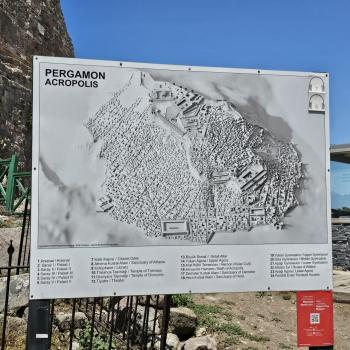The Latin word syllabus derives from the Greek word sillybos/ sillyboi. What it refers to in the first instance is the tag attached to a papyrus roll by which its contents is identified. One example of an actual tag from antiquity reads ‘Hermarchus, ‘Against Empedocles’ Book 9′. There was no
Dewey Decimal or Library of Congress system of labeling and cataloging rolls and codexes in antiquity, and so instead what was done was two fold: 1) a book list of rolls and codexes owned would be drawn up, often by topic and usually in (Greek) alphabetical order, and 2) a ‘sillybos’ would be attached to the roll so it could be distinguished from other ones, and readily found.
I am currently reading an excellent collection of essays entitled Ancient Literacies edited by William Johnson of Duke and Holt Parker of Cincinnati and it has many insights of direct relevance to NT studies. In this particular post I want to focus on the tags themselves. Libraries whether public or private could range from small to enormous collections of rolls. Obviously if one had only a few, tags might not be necessary. But this would rarely be the case when we are talking about a private library, and never when we are talking about great public libraries like the ones at Ephesos or Alexandria.
It was the theory of Martin Hengel, followed by Graham Stanton, that the tags applied to the Gospels ‘kata matthaion’ etc. were used once it became necessary to distinguish one Gospel from another. ‘According to Matthew’ of course implies there are others ‘according to someone else’. In fact it was Hengel’s argument that this sort of header would first be used when all four Gospels were put together in a single codex, probably sometime in the early second century A.D. The problem with this theory is that if they were in a codex, one would expect only an omnibus header like ‘euangellion’ since the codex would contains multiple Gospels. This in turn suggests that the header ‘kata matthaion’ was first applied to these Gospels in the first century when they still circulated as individual papyri rolls but at a time when there were various Gospels in play. Luke 1.1-4 suggests this was already the case when he wrote that Preface. Now we may debate when that was of course (in my view it has to have been sometime in the 70s or 80s if Luke used Mark and Q, which seems reasonably certain), but we need to not neglect the implications of these ‘titles’ created not in the second century, but rather in the first, before the first four Gospel codexes were produced.
The first point from a close study of the nature and function of ancient sillyboi is that the names applied to the documents were not random later guesses. They were names associated with the document as either author or compiler or editor of long standing. What is never the case is that the name appended to the document was that of a mere copier of the document, a scribe’s work. When one looks at the ancient books lists, there can be little doubt that authorship claims are being made— Plato wrote the Republic, and so on, and the syllaboi were produced by just copying what was on the book list onto the tag or vice versa.
The second point is that ancient collectors of rolls and scrolls tended to collect those that belonged in a certain group– for example a collection of medical treatises, or a collection of philosophical works, and so on. There is no reason to think early Christians would not have grouped things topically like this as well. When we look at the NT canon, this is pretty much exactly what we find— Gospels followed by Acts followed by letters, discourses, sermons, followed by an apocalypse. In other words genre or theme and topic were ordering principles. George W. Houston in his helpful article “Papyrological Evidence for Book Collections and Libraries” remarks “ancient booklists were very probably organized first by literary genre (epic, say, or lyric) or, where literary genres did not apply, by subject (medicine, astronomy) and then alphabetically by author.” (p. 243).
The third point of interest is that the sillybos tended to be added to the end of a papyrus roll, because in antiquity as in modernity with VHS tapes, people were often lazy and did not rewind documents on rolls. When rolls were turned into codexes, then the identifier was more likely to be on the first page of a codex. It needs to be stress as well that the beginning and end of documents were most likely to deteriorate, and this is exactly what we find in the ancient book lists. Especially the exposed end to a document was likely to lose something over time (see probably Mark 16.8ff).
In our next post we will need to say some things about literacy, first of all, in the cultural context of Jesus. As a preview, I am going to question at some length two assumptions you often find in works by some NT scholars: 1) that Jesus and his immediate followers were illiterate peasants. In general we may be suspicious of such a claim since the Gospel evidence suggests otherwise, and indeed there was a good reason why observant Jewish males ought not to be illiterate— they had a sacred text by which they were supposed to live, which while they could hear it read by others, the text exhorted them to read it for themselves!; 2) that the only thing that counts towards estimating literacy levels is ‘literary texts’ or the lack there of. To the contrary, ostracons, graffiti, business documents, marriage contracts, census records and any and all sorts of literacy needs to be taken into account












